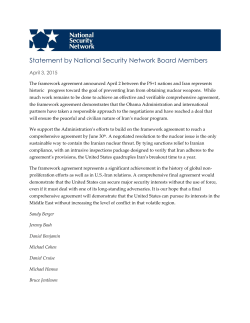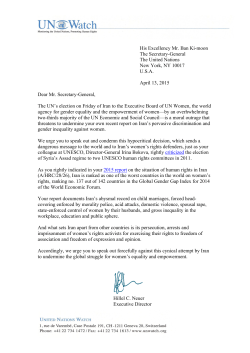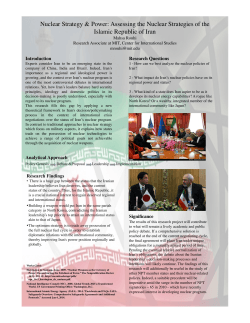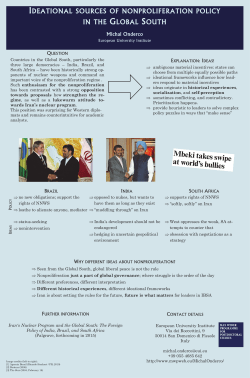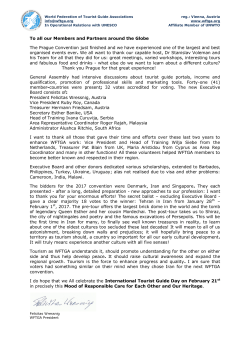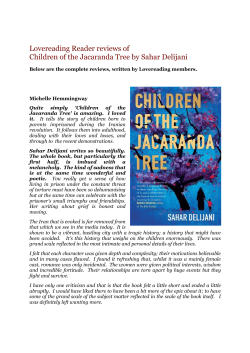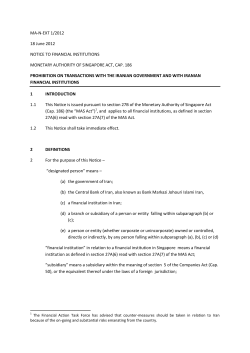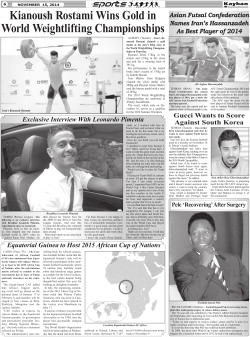
Latest Newsletter
www.VerityIran.com First published: February, 2015 Published: February 42 2015 Approaching the end-game (again) The markets paint a generally dismal picture of Iran’s economic trajectory over the past two months since talks were extended in November. Stocks are down 15%, the rial has lost 6% and meanwhile oil prices continue to dive with alarming implications for the government’s spending plans. A dramatic shift in political sentiment is needed if hopes of a nuclear settlement and economic revival are to stay alive. Iran’s negotiations with the P5+1 resumed on the 18th January with little sign yet of a significant shift in sentiment. Familiar statements emerged from each side following the two-day talks but negotiators remain deadlocked over the same technical details. VerityIran’s source revealed that whilst the framework for a deal is arguably close to being established, the atmospherics are nowhere near the levels of late October, when the positive momentum had made the final steps to a deal appear within reach. In our November newsletter, we argued that the seven month extension to nuclear talks only realistically has a four month shelf-life due to the prevailing political dynamics in Iran and the US. As we enter the endgame of nuclear talks, with only two months to go until that point, VerityIran believes something dramatic will be required to shift mind-sets and reignite hopes of a deal. President Rouhani’s comments this month on the use of referenda in Iran to decide “issues of national importance” looked like they might provide a much needed stimulus to the nuclear debate. The President did not explicitly propose a referendum or connect the idea to Iran’s nuclear programme, but much of the Iranian commentariat subsequently did that for him. The President also fired a thinly veiled critique at Iran’s hard-line figures and entities, which abide to “revolutionary values” even when they are at the expense of national interests, and at certain state bodies who are granted excessive privileges. The President’s statements have raised public awareness and expectations about the institutional obstacles that stand in the way of the more open economic future his administration has in mind. Unfortunately, the window available to reverse those obstacles and win the debate on economic reform and a nuclear settlement is closing rapidly. @VerityIran contactus@verityiran.com Page 1 of 4 www.VerityIran.com A sense of pessimism since last November has chilled the Iranian stock market. Fig 1 reveals the 15% drop in stock market value since the November talks failed to deliver a resolution. Of course, in parallel there has been a rather shocking descent in the oil price, and this too has weighed heavily on investor sentiment. On the 21st January a protest broke out in the Tehran Stock Exchange against the government’s “indifference and lack of clear targeted policies” to tackle the plummeting stock values after a second sharp decline in two weeks. The oil market’s relentless descent has continued over the past month, with analysts now speculating over the extent of the damage to long term prospects. Brent crude prices fell to $45 per barrel, a six year low. Fig 3 shows the 60% drop in prices since June 2014, and the more than 40% drop off since the last round of nuclear negotiations ended in November 2014. VerityIran has long argued that nuclear negotiations will sink or save the Iranian economy; the oil price shock of the past six months only strengthens our view. Brent crude oil price forecasts are now stuck around US$50-$55 per barrel for 2015, rising only slightly to US$60-$66 per barrel in 2016 as the reduction in investment feeds through into future production. The fundamental trends are clear. Fig 4 shows global crude oil supply and demand projections to 2018, which reveal a long period of surplus oil production that will trap prices. Amidst the gloom, there was some good news for Iran’s oil industry as crude exports to Asian customers were reported to have beaten expectations. Fig 5 shows Iranian crude exports to Asia in the year to November 2014, 11% up on the same period a year earlier. First published: February, 2015 Fig 1. Iran’s Stock Exchange (TEPIX) Daily index (August 2014 to present) 78000 76000 74000 72000 70000 Nuclear talks end 68000 66000 64000 62000 60000 58000 36000 Fig 2. Rial/USD unofficial market exchange rate 24 November 2014 to present 35500 35000 34500 34000 33500 Nuclear talks end 33000 32500 32000 120 Fig 3. Brent Crude oil spot price USD per barrel 110 100 90 80 70 The debate over the government’s budget proposals for Since nuclear 60 talks ended 1394 rumbles on, mostly targeting the administration’s 50 oil price estimates, which balanced the books with a 40 US$72 per barrel forecast. This is clearly much higher than consensus expectations for Iran’s oil revenues and the implications are profound for government expenditure. Departmental budgets are surely to come under even greater pressure and development spending (i.e. capital investment) is likely to be sacrificed with depressing @VerityIran contactus@verityiran.com Page 2 of 4 First published: February, 2015 96.0 Fig 4. Global oil supply and demand, Million Barrels of oil per day Supply 94.0 92.0 90.0 Demand 88.0 86.0 84.0 82.0 80.0 78.0 2005_Q1 2005_Q4 2006_Q3 2007_Q2 2008_Q1 2008_Q4 2009_Q3 2010_Q2 2011_Q1 2011_Q4 2012_Q3 2013_Q2 2014_Q1 2014_Q4 2015_Q3 2016_Q2 2017_Q1 2017_Q4 2018_Q3 www.VerityIran.com consequences for medium and long term growth prospects. The Majlis Research Center proposed a new forecast of US$60pb to the Joint Budget Commission, which is still much higher than the current rate. Finance and Economy Minister Ali Tayebnia appeared to announce an amendment to $40 per barrel, which he later repudiated. The government has defended its ability to cope with the drop in prices via emergency mechanisms – the constitutional budgetary commitment to the National Development Fund was recently slashed to 20 per cent for example - but under current financial constraints the price shock appears devastating for Iran’s spending plans over the next financial year. The fragility of Iran’s development budget was Fig 5. Iran crude imports Average barrels per day, year to November exposed with revelations that only 10% of scheduled Year to Nov 2014 Year to Nov 2013 construction projects had secured financing this year. 1,200,000 Investment projects with long term benefits for the 1,000,000 productivity of the Iranian economy are being almost universally mothballed. This also marks a substantial 800,000 shift in fortunes for the IRGC’s giant engineering firm, 600,000 Khatam-al-Anbia, which operates a monopoly on infrastructure development. In a further blow for the 400,000 firm, the Joint Budget Commission announced that as of 200,000 next year the Khatam-al-Anbia HQ, alongside the Imam 0 Reza Foundation will lose their preferential tax status China India Korea Japan Total and be required to file tax returns. These are positive signs of action in tune with the President’s rhetoric on economic reform. The latest data suggest that inflation continues to track downwards. Official statistics from the Central Bank of Iran suggested consumer price inflation had fallen to 16.3%, year on year in Dey 1393 (released in January 2015). This figure was supported by the Statistical Centre for Iran’s own estimates. VerityIran’s calculations, based on a mixture of official statistics and price monitoring place the rate higher, although the discrepancy between our own estimates and official estimates has reduced somewhat in the past year. Fig 6. Official Consumer Price Index % Year on year change 50.0% 45.0% 40.0% 35.0% 30.0% 25.0% 20.0% 15.0% 10.0% 5.0% 0.0% @VerityIran contactus@verityiran.com Page 3 of 4 www.VerityIran.com First published: February, 2015 Amidst this difficult economic backdrop, there are continued signs that investors remain poised and ready to move if and when sanctions are peeled back. In the corridors of the Kish island energy fair in January, the National Iranian Gas Company (NIGC) Investment Committee Head said more than 40 companies from the US, Europe and Asia had engaged in discussions about investment in Iran’s gas industry. The investment opportunities being discussed included South Pars gas transfer projects. There are other stories of success outside the oil sector in Iran too, despite the dismal economic climate. Iran’s cement industry is booming thanks to reconstruction projects in Syria, Iraq and Gaza – the fastest growing in the world by all accounts and an increasingly important foreign exchange earner. Also, the Majlis Research Centre announced that non-oil exports in the first six months of 1393 were up 20% on the same period a year earlier. And there are reports that Iran expanded its non-oil exports to Russia by 20% in 2014, selling fruits, vegetables, carpets, tea and cars. @VerityIran contactus@verityiran.com Page 4 of 4
© Copyright 2025
